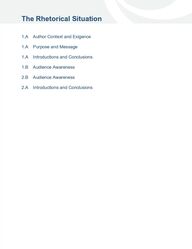
Return to flip book view
Message The Rhetorical Situation1.A Author Context and Exigence1.A Purpose and Message1.A Introductions and Conclusions1.B Audience Awareness2.B Audience Awareness2.A Introductions and Conclusions
Lesson 1: The Rhetorical SituationUnderstanding the Rhetorical SituationKey ConceptsRhetoric refers to the choices that a person makes to communicate effectively with an audience.The rhetorical situation refers to everything involved in making this effective communication happen: Author's identity, expertise, and perspective Audience's knowledge, beliefs, and values Message the author delivers to the audience in order to achieve a purpose Context in which the author develops and/or delivers a message Exigence that prompts the author to develop a messageStatements in a passage may directly supply this information or provide clues about these elements and appear in any order throughout the passage. 1.A Author, Exigence, and ContextBrandi's Bid Episode 1As a reader, it's important to identify details that are directly or indirectly revealed about the rhetorical situation and consider how these elements affect the way a message is crafted. Consider how these elements are used in a real-life situation involving a student writer. In the story above, you are given background information about this student author. You may not always have much information about the author of a passage, but by reading carefully, you can draw inferences about the author's background or perspective and their reasons for making the choices they did. Authors may provide information about themselves to establish their credibility with the audience. For example, when writing about the disappearance of her language and culture, a Native American author would want to talk about having Native American heritage.
Lesson 1: The Rhetorical Situation The event, insight, or concern that motivated the author to write is called exigence. To identify exigence, you will need to make an inference from the author's statements about a recent event, current situation, or specific problem. Read with this thought about exigence in mind: What is the major concern or situation that prompted the author to write? The context of a passage refers to the circumstances under which it was constructed, such as the events or issues weighing on the moment when the author wrote the text. Context can also refer to the text's genre, the type of publication from which it was excerpted, or its area of focus (e.g., academic discipline or category of concern). Understanding the historical context in which the text has been written can help you better understand the author's perspective and the experiences and mindset of the audience. For example, a text written in the 19th century might reflect a society in which traditional gender roles and class structures strongly affect people's beliefs and behaviors. On the AP exam, the introductory statement above a passage gives limited but important information about the passage's context, such as what kind of text it is (speech, essay, book excerpt, etc.) and when it was published. Sometimes relevant information about the author or audience also appears, such as the occasion on which an individual delivered a speech. Anything about the context that is not stated in the introductory information must be discovered by noting what the author states directly or indirectly in the passage.Activity: Identify and Reflect on Author, Context, and ExigenceThe introductory information and the first two paragraphs below are from a passage similar to those you will see on the AP exam. In each section, highlight statements that inform you about the passage's author, context, and exigence and write a brief annotation about what they reveal about these elements of the rhetorical situation. Remember, this information can be provided or implied in any order. Then click the Suggested Response below each section to reveal suggested highlights and comments about the elements of the rhetorical situation for which it provides information.
Lesson 1: The Rhetorical SituationThe article below was recently published on an educational blog dedicated to the use of technology in schools. Suggested ResponseThe global gaming community has exceeded 3 billion enthusiasts, and I count myself among them. It may surprise you to learn then that I am the principal of a public high school in Upstate New York. However, if you have been paying attention to one of the fastest growing industries in the country, my enthusiasm is not likely to come as much surprise. Whether it's on mobile devices, consoles, or desktops, gaming boasts one of the largest user bases globally, surpassing the combined market size of movies and music. Official tournaments for popular games draw millions of viewers, and professional esports teams secure substantial sponsorships and prize money. In 2019 alone, players in over 5,400 tournaments earned more than $235 million. As another reflection of the escalating popularity of esports, the International Olympics Committee recently introduced Olympics Esports Week, scheduled for June 22-25, 2023, offering a virtual platform for e-athletes to compete in games related to sports. Suggested Response Despite the growing popularity of esports, I recently received an email from a parent who expressed concerns about our school’s esports program. She questioned why we encourage students to waste time on “mindless video games” instead of academically focused activities like chess and debate or “real” sports like basketball and soccer. She indicated she would be contacting the school board to get answers. I think it’s important that I share with fellow educators what I have experienced and expand on what I shared with this parent.Suggested Response